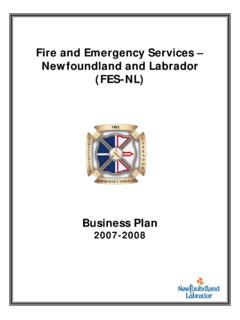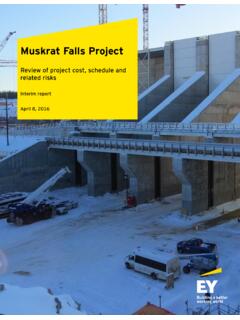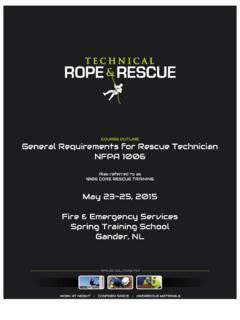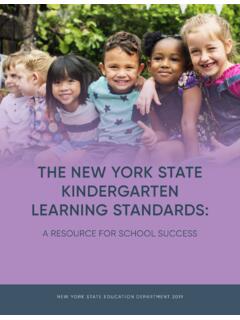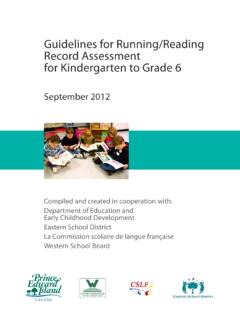Transcription of Assessment Techniques and Tools for Documentation
1 COMPLETELY kindergarten - kindergarten CURRICULUM guide - INTERIM EDITIONASSESSMENT Techniques AND Tools FOR DOCUMENTATION47 Assessment Techniques andTools for DocumentationCOMPLETELY kindergarten - kindergarten CURRICULUM guide - INTERIM EDITIONASSESSMENT Techniques AND Tools FOR DOCUMENTATION48 Assessing the kindergarten Student s Learning Assessment and evaluation are fundamental components of teaching and learning. Assessment is the process of collecting and documenting information on individual student learning, while evaluation is the process of analyzing, reflecting, summarizing and making decisions based on this information. The purpose of Assessment is to inform teaching and improve learning. Hence, Assessment of learning and Assessment for learning are integral parts of the teaching and learning process in the kindergarten classroom.
2 Teachers should recognize that many factors influence learning and achievement. A student s success in demonstrating what he/she knows or is able to do may vary. His/her level of success may depend on such factors as the time of day, the situation, the type of questions asked, familiarity with the content and child s willingness to perform at any one time. Children require ample time to demonstrate their achievements through varied learning opportunities that are developmentally appropriate and within the range of things that they can do independently. The rate and depth which individual students will engage in the kindergarten curriculum will vary from beginning to end. Learning is active in the kindergarten classroom.
3 Therefore, assessing the process of learning is critical and it should occur while the learning is happening rather than assessing the final product. Ongoing Assessment informs the approach needed to design and deliver developmentally appropriate instructional activities. The best opportunities to assess student learning occur within natural classroom instructional encounters with students working individually and in small and whole groups. Assessment is frequent, well planned, and well organized so that teachers are able to assist each child in progressing towards meeting the kindergarten curriculum kindergarten - kindergarten CURRICULUM guide - INTERIM EDITIONASSESSMENT Techniques AND Tools FOR DOCUMENTATION49 Assessment Tools A variety of strategies and Tools should be used to assess children s learning on an ongoing basis in the context of everyday classroom experiences.
4 Assessment strategies should encourage children to show what they know and what they can do, rather than focusing on what they do not know or cannot do. Focusing on children s thinking rather than a particular answer or solution provides valuable information about a child s learning. Sometimes their thinking is evident through their dialogue or it can be demonstrated through their behaviors. The kindergarten teacher s greatest Assessment tool is a continual process of observation and Documentation of learning because young children show their understanding by doing, showing and telling. Therefore, teachers need to use the Assessment strategies of observing, listening and asking probing questions to assess children s achievement.
5 In addition to documented observations, other Assessment Tools include anecdotal records, photographs, videotapes or tape recordings, checklists, work samples and portfolios, conferencing and language arts student profiles. The Assessment Tools used should be consistent with beliefs about curriculum and classroom practices. They should clearly reflect student progress towards the attainment of curriculum outcomes outlined in the kindergarten program. Best Assessment practices occur frequently and they are planned to fit throughout the organization of the kindergarten Observations in the Classroom Documentation is an essential element of reflective practice. It makes children s play and learning experiences children, parents and teachers.
6 It is a way to visibly demonstrate the competence of the child. Observations of student interactions and engagements with materials and other students within the classroom is a valuable means of assessing student learning. Documentation of these observations provides an authentic account of a student s learning and it shows accountability when planning and communicating each student s progress. Documentation simply means keeping a record of what is observed while students are engaged in a learning experience while playing and exploring. Records might include teacher observations which focus on specific skills, concepts, or characteristics outlined in the kindergarten curriculum. Daily observations may be both planned and spontaneous to ensure that all learning experiences that may emerge from a particular activity are included.
7 COMPLETELY kindergarten - kindergarten CURRICULUM guide - INTERIM EDITIONASSESSMENT Techniques AND Tools FOR DOCUMENTATION50 There are various forms of documenting a student s learning experiences. It might include the use of student s artwork and writing, photographs, videotapes and/or tape-recordings. Documentation can be as simple as an attractive display of children s work on a wall or it can be a more elaborately crafted display board that tells the story of an experience of a child or a group of children. Various types of Documentation may include display boards, scrap books, photo albums, web sites (accessible only to parents), and emails to parents, bulletin board displays and newsletters to parents. All types of Documentation should include a title, photos or sketches of children s work with written captions, children s illustrations of the experience and additional written descriptions of the learning.
8 Documentation pulls it all together for the students, teachers, and the parents. It provides students with the opportunity to revisit their work which, in turn, provides teachers with the opportunity to discuss with them their interests, their ideas and their plans. By becoming involved in the Documentation of their own learning experiences, students become more reflective and more engaged in the learning that is happening all around them. COMPLETELY kindergarten - kindergarten CURRICULUM guide - INTERIM EDITIONASSESSMENT Techniques AND Tools FOR DOCUMENTATION51 Anecdotal Notes Anecdotal notes are short narrative descriptions of observations in the classroom. Teachers may choose to write their comments on adhesive labels or Post It Notes for each child.
9 This allows the teacher to jot down quick notes about the children who are being observed as he/she moves about the room throughout the day. These notes are later transferred and organized into a binder or exercise book containing pages for individual students. It is important to date each note so that progress can be tracked over a period of time. Anecdotal forms may be included in some teacher resources and teacher preference will determine the format used for anecdotal reporting. It is impossible to include anecdotal notes for each student daily but a conscious effort to observe all students over a period of time is necessary. Photographs, Videotapes and Audio Recordings Photographs, videotapes or audio recordings of learning experiences are great forms of Documentation and are very useful when assessing student learning.
10 They may include pictures of students at a block centre during the construction process, a recording of them talking with peers as they use materials at a water table, or a recording of a student reading a story with a friend. COMPLETELY kindergarten - kindergarten CURRICULUM guide - INTERIM EDITIONASSESSMENT Techniques AND Tools FOR DOCUMENTATION52 Self-AssessmentStudents learn about themselves as learners and also about their learning through self- Assessment . The statements made by students themselves are an indication of their knowledge and feelings when they are engaged in a learning experience. Opportunities for students to reflect on their learning should be provided by the teacher. Student reflections may include audio, video or printed recordings and work samples.

